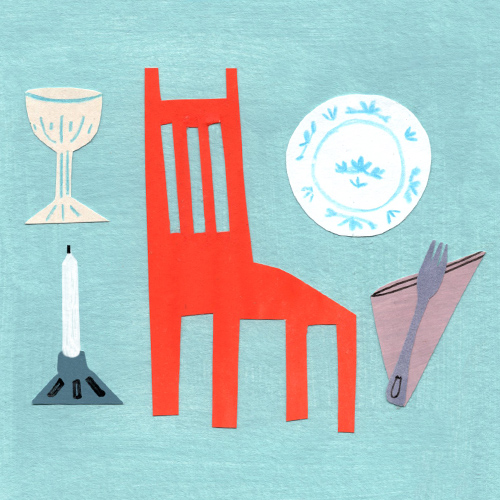Raised in the latter days of the mannered South, I was schooled daily, hourly—minutely—on the proper ways to speak, dress, eat, move, and sit. My parents imparted these lessons wherever we happened to be, whether at home, out in public, or at their higher-end antiques shop in downtown Greensboro, North Carolina. They told me what I ought to think about countless topics, which strikes me as ironic now, given how they railed against whatever they considered narrow-minded. They were socially liberal Democrats who despised Republicans and religious zealots—“Christ-bitten” “holy rollers” and “Bible beaters”—who struck them as greedy, censorious, bigoted hypocrites, lacking both compassion and imagination. On the other side of the fence, my parents had limited patience with hippies, Moonies, and New Agers; these folks were naive or shiftless. Their pot-befuddled talk was boring, and their self-righteousness as dull as that of their conservative counterparts.
And yet, even as my folks condemned other ideologues’ blind conformity and preached about the rewards and virtues of individualism, they demanded complete obedience at home. They held my brother and me to a high standard of behavior. My mother, for instance, deemed it common to chew gum or use a toothpick in public. These were things that a lady, especially, did not do, and I understood early on that it was my job to become a lady. A lady did not paint her fingernails, pierce her ears, or wear an anklet; a lady crossed her legs at the ankle, never the knee. A lady expected a gentleman to hold the door for her, to help her with her coat, to wait for her to be served first. These were manners, and if you learned them as a child, they’d be second nature to you as an adult.

Our posture required constant correction, as did our grammar. Out in the world, my mother warned, you’d be judged not only on how you spoke but your choice of topic. Nice people simply did not talk about certain things in front of people whose affiliations they didn’t know: politics, race, religion, sex. (Also, my father added, ACC basketball.) It was inexcusable to use racist language, act superior, or talk down to those in service positions, but you shouldn’t make trouble by calling out acquaintances or strangers when they did these things. Also déclassé was discussing how much money you’d spent on something, whether it was a bargain or an extravagance.
Gradually, I came to understand the distinctions my mother was making among “people without your advantages,” “nice people,” and the “nouveaux riches,” who were “trying too hard.” She was teaching me about the social divisions of money and class. Alert to all the signifiers, large and small, of those differences, she wanted to be sure that I learned them, too. It was important that I understand what the world—meaning the white, middle- and upper-class world she knew best—was going to think about me if I wore too much makeup or said, “Me and him are going to the store.”
Fast-forward to me fussing at my son to wear a button-down instead of a T-shirt when we went to the theater or an upscale restaurant. Nice people do things a certain way, and doesn’t he want people to think he’s nice? Like my own mother and father, I’ve tended to parent with the volume turned up to eleven: small infractions incite big reactions. I’m stricter than they were about certain things and more lenient about others. So far, I’ve done little to inculcate in my son the aesthetic principles imparted to me throughout my childhood as sacred, empirical truths. Whether I ought to feel badly about this neglect, I don’t know.
Here are the articles of faith my mother taught me about decorating a house:
When arranging objects, a symmetrical arrangement is most pleasing, but an asymmetrical arrangement is also pleasing, if well balanced.
Less is more. (But our family’s less is still a lot.)
Good quality but a bit worn is better than new, shiny, and cheaply made.
Avoid “the furniture store.” (It’s impossible on the page to invest this phrase with the scorn in my mother’s voice. The furniture store to me sounded like what Hell must have sounded like to children of evangelicals.) Even if you have to spend more for a decent antique, at least you’ll have a real piece of furniture.
Every room must contain something tall, something short, and something red.
Vary the vertical and the horizontal.
Never, ever catty-corner a large piece of furniture like a bed or a wardrobe.
Inexpensive things attractively arranged make a more pleasing environment than a lot of expensive things poorly arranged.
Simple and elegant is best, but a little fabulous here and there doesn’t hurt either.
No matchy-matchy.
While you must put a lot of thought into the way you decorate a room, you don’t want a room that looks tarted up or like you are trying too hard.
Having bad opinions on decorating is preferable to having no opinions at all. When a room looks terrible because it was purposely made to look that way, we don’t admire the result, but we can respect the people who decorated it for at least having the guts to express themselves.
Above all else, a well-appointed room conveys a sense of ease. A successful room, like a successful person, is permitted to exhibit flare, even high drama or eccentricity, as long as it exudes confidence. There must be no hint of striving or trying to present a false image, of pretending to be what you’re not.

Growing up, when my mother mocked pretentious errors of taste, I thought she was right to criticize. A person ought to be an individual and not conform to herd mentality; people ought not put such stock in showing off how much money they have. It didn’t occur to me then that if you start out with little and then make some money, you might want brand-new possessions because you can, for the first time, actually afford them. You might want to enjoy them as evidence of how far you’ve come in the world. Nor did it occur to me that you might not care for antiques because, to your eyes, they represent the long-standing and exploitative wealth of a class of people you dislike or envy or resent, people who actively oppressed you and yours. And while I knew that I was being taught that striving for status and prioritizing money are not things that nice people do (or, rather, appear to do), it took a long time before I recognized the implication that nice people are those who have already “made it” in the world, preferably generations before, and that the things they own—their inherited furniture and old silver and family portraits—are the proof.
When my parents married in 1961, they received the usual silver, china, glassware, and table linens that middle- and upper-class people in those days thought a young couple must possess in order to entertain properly. A photograph shows the wedding gifts displayed for visitors to view: a row of ivy-garlanded silver trays lined up like shields on a Viking longship.
My mother barely used any of that stuff. She couldn’t be bothered to haul it out of the cabinet, wash off the dust, then hand-wash it all again after it had been used. In her adult life, Mom had neither the money nor the motivation to keep a large house, but she’d been raised with that genteel standard, and part of her held on to it as the ideal. Her parents’ house was always “down home,” and the way things were done there was the right way.
I, too, find it easy to be nostalgic about my grandparents’ house—about, among other things, the beautiful table set for holiday dinners. My grandfather—we called him Daddy-Jack— would cut branches of holly and evergreens from the yard and arrange a centerpiece of greenery, fruit, and nuts. We’d dress the long, glossy table with white placemats and pressed damask napkins, silver flatware, heavy water goblets and wine glasses, and Granny’s Wedgwood china with the blue-green band. The children’s table, sensibly, was set with the everyday dishes. Once, when quite small, my brother protested because his place setting wasn’t the same as the adults’. My mother tried to quiet him, but Daddy-Jack crowed, delighted: “If the child wants a bread-and-butter plate, he shall have it!”
Part of me wants to set those beautiful tables for my son and friends, for myself, but I haven’t forgotten the pressures underlying that standard, the harried hours preparing for those occasions, the tedious cleaning after the meals were demolished. Even with my grandparents’ hired housekeeper cooking the meal, the women in the family spent hours washing, drying, sweeping, vacuuming. Picking meat from carcasses, coaxing stains out of linen. I could wax nostalgic about our female camaraderie, but the fact is, the work was exhausting. Better to tell you about the holiday when I railed at the unfairness of the boys not being made to help in the kitchen, how my aunts burst into shocked laughter when I declared that I might as well flop out a breast and wipe the counter down with it, since drudgery was what my female body was apparently built for.
My family lavished admiration on what pleased them and excoriated what didn’t. Hearing how they talked about people they found lacking, I tried never to do anything to provoke anyone to talk about me that way. Departing from their ideals of aesthetics, family, and womanhood—excuse me, ladyhood—was something I knew they’d see as a grave act of disloyalty, and in my youth, I wasn’t about to commit that cardinal sin. (At least, not where they could find out about it.)
But as I grew older, I tired of all those damn rules. As much as I loved my family and wanted to please them, I needed to find my own way. The perfect Christmas or Thanksgiving? The house beautiful? Why set myself up to fail? Why waste the time? There are too many places to go, too much writing to do.
If I have one rule now about furnishing a house, it’s this: My house must contain books—lots of books. The rest is negotiable.

On any given day, my house is simply home, the place where everything is familiar. But when a guest comments on all my old things, I look at my home with different eyes. I remember that it’s unusual for a writer and university lecturer to own so many antiques, and I find myself explaining about my parents, my family. I act as though none of it has been my doing, this putting together of a home that’s attractive and comfortable, that reflects my personal history and taste.
Your personal aesthetic is a product of your experience: an expression of it, a reaction to it. You continue what someone else started or you turn away from it. Or, like me, you do both.
I wonder what I’d choose for myself if I hadn’t inherited all these things. If I had to start now with an empty house and the money to furnish and decorate it, I suspect the result wouldn’t end up looking markedly different from my house now. After all, it’s too late to undo my early training in decorative matters—I tend to prefer old things to new—and antiques have become so devalued that they’re now more affordable than good-quality new furniture. I’d choose an eclectic mix of styles and periods; I’d go for darker wood over light; clean lines over rococo. I’d buy work by contemporary artists to mix in with old paintings and prints. The dishes would be pretty but utilitarian. Books, of course, lots and lots. In each room, per the rules I learned at my mother’s knee, a mix of horizontal and vertical, hard and soft, vibrant and neutral. There must be symmetry and something red.
Last Christmas we didn’t visit family or have anybody over because of the pandemic. As much as we missed seeing folks, it was nice not to drive anywhere or need to work out elaborate plans. I spent the holiday in my pajamas, assembling a 1,000-piece Frida Kahlo puzzle, while my husband roasted a chicken and my son messed about with his gifts.
This year, now that we’re all vaccinated, we’ll spend time with family at Christmas, cook up a bit of a feast. Thanksgiving, though, we’re keeping easy. I’ll wear yoga pants and read a novel on the sofa while my husband stirs a roux for gumbo and sets off the smoke alarm. When it’s time to eat, we’ll use our regular dishes and forks because we don’t have “nice” ones—I got rid of the china and silver. The house will no doubt be a mess. We’ll eat pie, walk the dog, chat with neighbors outside, Zoom with family, maybe watch a movie. It’ll be a case of “less is more,” and the only rules will be that we spend the day together and help each other out. I’ll be grateful to know I don’t have to do any more than that.
Julia Ridley Smith is the author of a memoir, The Sum of Trifles (University of Georgia Press, 2021). Essays from the book have appeared in Ecotone, the New England Review, and Southern Cultures, and been recognized as notable in The Best American Essays. Her fiction has been published in Alaska Quarterly Review, Electric Literature, The Southern Review, and elsewhere. She is currently the 2021–22 Kenan Visiting Writer at UNC Chapel Hill. Find her at juliaridleysmith.com and follow her @JuliaTrifles.
Excerpts from “The House Beautiful . . . or the House Good Enough” from The Sum of Trifles © 2021 by Julia Ridley Smith. Reprinted by permission of the University of Georgia Press.

